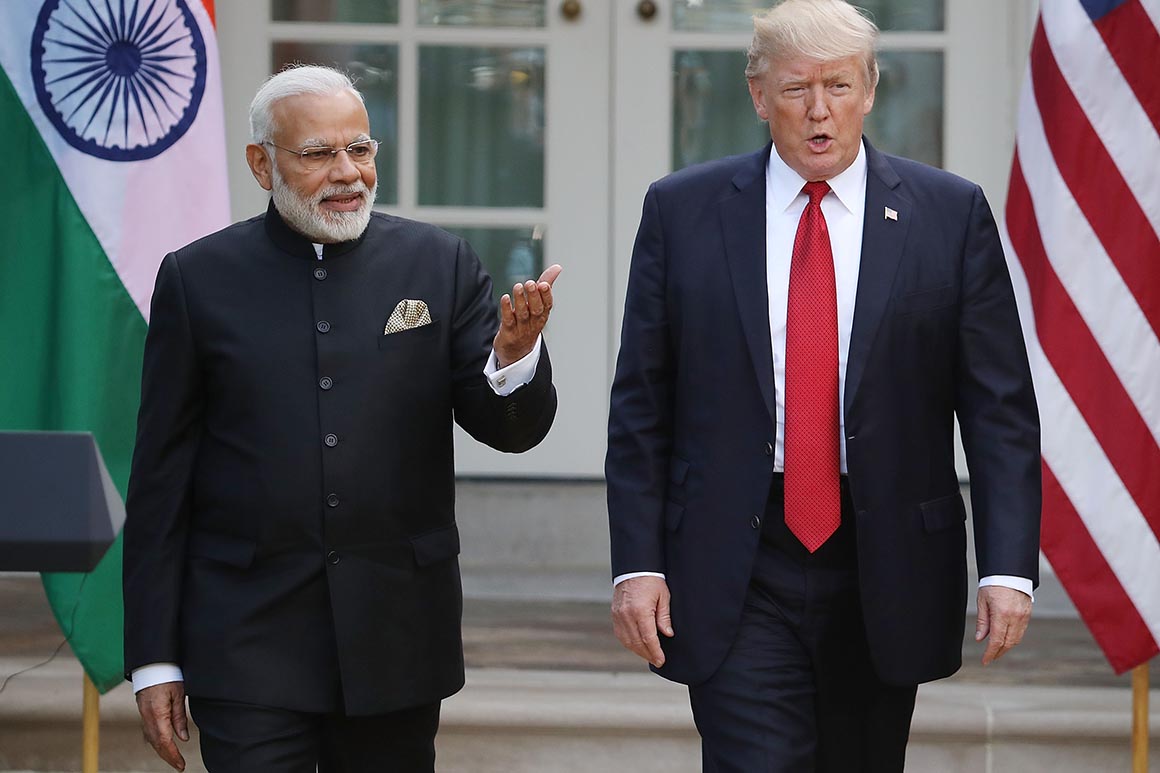
“We may make a tremendous deal there, or maybe we’ll slow it down. We’ll do it after the election. I think that could happen too,” Trump said at a Thursday rally. “But we’re only making deals if they’re good deals, because we’re putting America first.”
A senior administration official said a „wide scope“ of issues have complicated progress toward a mini trade deal.
„We want to address a lot of concerns and we’re not quite there yet. We will likely have discussions with the prime minister about these concerns,“ the official said in a call with reporters on Friday.
India is expected to announce some significant purchases of U.S. energy and defense products, but Trump’s fixation with imbalanced trading relationships is likely impeding any willingness to offer New Delhi any concessions.
India is the United States’ ninth-largest trading partner. The U.S. exported about $34 billion worth of goods to India in 2019, just a fraction of the $256 billion exported to Mexico, the top destination for U.S. goods last year.
Indian policies in a sense represent what Trump wants to do himself: protect domestic manufacturing and farmers through tariffs and quotas as a way of winning over important voting blocs.
The U.S. recorded a $24 billion trade deficit with India last year while India’s exports to the U.S. grew at a faster rate than U.S. exports to India. Those statistics could be driving the president’s reluctance to give India what it really wants — access again to the U.S.’ Generalized System of Preferences, a tariff-cutting program for developing countries that discounts duties on roughly $6 billion worth of Indian imports.
Policies that have fiercely guarded India’s markets have been the bane of multiple previous U.S. administrations. Even now, as India’s economy further slumps and pressure from neighboring China grows, New Delhi has continued to make protective moves. That includes a multiyear „Make in India“ initiative aimed at bolstering the country’s manufacturing sector through local sourcing and production requirements.
The administration official said recent actions New Delhi has taken to bolster that program „are making the discussions a bit more difficult.“
India also released a national budget in late January that raised tariffs on a number of products that were under consideration to be cut or eliminated as part of a mini-agreement with the U.S.
U.S.-India Business Council President Nisha Biswal said India’s tariff increases on walnuts, medical devices and other goods that were to be part of a trade deal further “complicated” the talks.
The negotiations also got hung up on details related to increasing access for U.S. dairy products and credit card companies.
In addition, India has balked at starting a standing dialogue focused on digital trade issues — an area where U.S. firms have raised alarm over Indian proposals on privacy and data storage requirements, according to a person briefed on the talks.
U.S. businesses were hoping a limited trade package would be a confidence-building move for a more comprehensive negotiation.
„A large deal will take many months, and likely years, in the making,“ said Biswal, whose group represents companies that do business in India. „We are fundamentally looking at an Indian approach to trade that is still emerging and evolving from a more protectionist or closed trading system to a more open one.“
Modi’s latest actions may reflect efforts to drive domestic consumption and production in a nation also trying to stem a tide of cheap, Chinese imports and where a significant portion of the population still lives in poverty. India was also likely emboldened by the U.S. and other countries to stand firm or ramp up its tariffs.
“There have been steps in the global economy that have, also from the Indian perspective, felt like others were also pursuing some protectionist policies and the Indian feel like they want to follow suit,” Biswal added.
Trump could choose to step up the pressure on Indian exports to the U.S. in ways that would hurt its economy further.
For months, administration officials have weighed the launch of a so-called Section 301 trade investigation, a law that gives the president broad leeway to impose trade restrictions to address unfair trade actions. Trump used the same authority on China, which resulted in tariffs on hundreds of billions worth of imports, but no final decision has made on whether to apply it to India.
“I think the 301 process is one that will play out, but the focus right now from the executive branch I would say is trying to find the more proactive incentives for trying to get some of these issues resolved,” said Biswal.
At least this week, Trump may be content to maintain the warm relationship with a leader he views as a kindred spirit who can mobilize masses of supporters the president relishes. Modi’s visit to Houston in September where he held a joint rally with Trump brought the president one of his largest crowds. Trump has boasted that millions of Indians will be on the streets to greet him this week.
“It seems like this visit will be a roadshow, sort of a thank you for the ‘Howdy Modi’ event in September in Houston,” said Shruti Rajagopalan, a senior research fellow at George Mason University’s Mercatus Center. The Indian prime minister has „taken it upon himself to put on a very good show for Trump. If anything big happens on trade, it will be surprising, and a very spur of the moment idea.”
Source: politico.com
See more here: news365.stream






